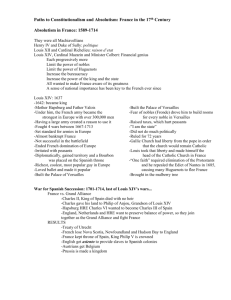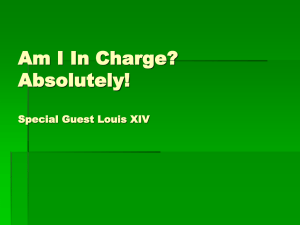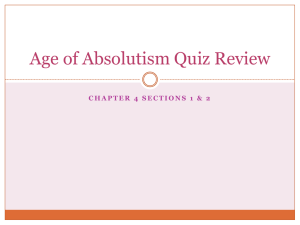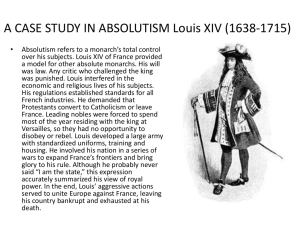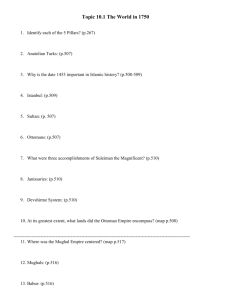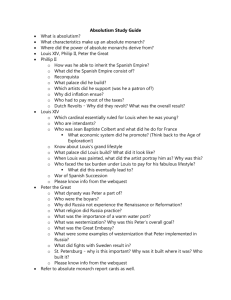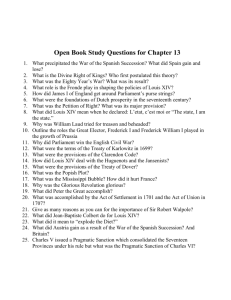Absolutism in Western Europe - AP EURO - AP EURO
advertisement
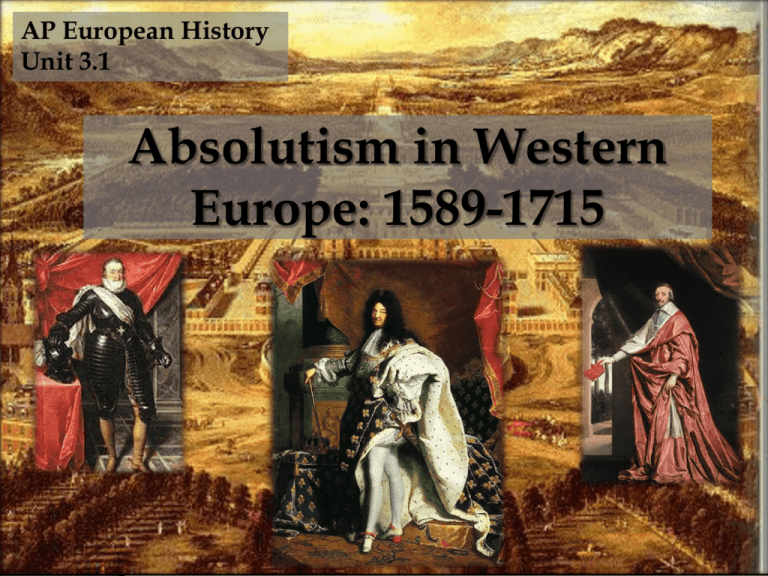
AP European History Unit 3.1 Absolutism in Western Europe: 1589-1715 I. Absolutism A. Derived from the traditional assumption of power (e.g. heirs to the throne) and the belief in “divine right of kings” -- Louis XIV of France was the quintessential absolute monarch B. Characteristics of western European absolutism 1. Sovereignty of a country was embodied in the person of the ruler 2. Absolute monarchs not subordinate to national assemblies 3. Nobility was effectively brought under control 4. Bureaucracies in the 17th century were often composed of career officials appointed by and solely accountable to the king 5. French and Spanish monarchies gained effective control of the Roman Catholic Church in their countries 6. Maintained large tanding armies during peacetime 7. Employed a secret police force to weaken political opponents 8. Foreshadowed totalitarianism of 20th century but lacked financial, technological and military resources of 20th century dictators (like Stalin and Hitler) C. Political Thought 1. Jean Bodin (1530-96) a. Among the first to provide a theoretical basis for absolutist states b. Saw the horrors of the French Civil Wars c. Believed that only absolutism could provide order and force people to obey the government 2. Thomas Hobbes (1588-1679): Leviathan, 1651 a. Humans in a state of nature: “solitary, poor, nasty, brutish” b. Political sovereignty is derived from the people who transfer it to the monarchy by implicit contract. c. Justified absolute monarchy (but not divine right) d. Hobbes was not popular in the 17th century. Title page from Hobbes’ Leviathan, 1651 3. Bishop Jacques-Bénigne Bossuet (1627-1704) a. Principal advocate of “divine right of kings” during the reign of Louis XIV b. Believed “divine right” meant that the king was placed on the throne by God, and therefore owed his authority to no man or group III. Development of French absolutism A. France in the 17th century 1. The Three Estates: feudal tradition for dividing various classes a. First Estate: clergy (1% of population) b. Second Estate: nobility (3-4% of pop) c. Third Estate: Bourgeoisie, artisans, urban workers, peasants. th 17 Century French Society 1st Estate: clergy 2nd Estate: nobility 3rd Estate Bourgeoisie, peasants, laborers 2. Hierarchy of social orders based on rank and privilege was restored under the reign of Henry IV 3. Society was primarily agrarian: 90% of population lived in the countryside 4. Largest population in Europe (17 million): France comprised about 20% of the European population B. Henry IV (r. 1589-1610) 1. Laid the foundation for France becoming the strongest European power in the 17th century 2. First king of the Bourbon dynasty a. Came to power in 1589 as part of a political compromise to end the French Civil Wars b. Converted from Calvinism to Catholicism in order to gain recognition from Paris of his reign c. Issued the Edict of Nantes in 1598 providing a degree of religious toleration to the Huguenots 3. Weakening of the nobility a. “Nobility of the sword” not allowed to influence the royal council b. “Nobility of the robe”: new nobles who purchased their titles from the monarchy and became high officials in gov’t ; remained loyal to the king (e.g. Duke of Sully) 4. Duke of Sully (1560-1641): Finance minister for Henry IV a. Reforms enhanced power of the monarchy b. Mercantilism: increased role of the state in the economy in order to achieve a favorable balance of trade with other countries c. Reduced the royal debt d. Reformed the tax system to make it more equitable and efficient e. Oversaw improved transportation • Began a nationwide highway system • Canals linked major rivers • Began a canal to link the Mediterranean Sea with the Atlantic Ocean 5. Henry was assassination in 1610 by a fanatical monk who sought revenge for Henry’s granting of religious toleration a. Led to a severe crisis in power b. Henry’s widow, Marie de Medici, ruled as regent until their son came of age. C. Louis XIII (1610-1643) 1. As a youth his regency was plagued by corruption and mismanagement a. Feudal nobles increased their power. b. Certain nobles convinced him to assume power and exile his mother. 2. Cardinal Richelieu (1585-1642) a. Laid the foundation for absolutism in France. -- Like Henry IV, he was a politique who placed political principles ahead of religious ones b. Intendant system • Used to weaken the nobility • Replaced local officials with intendants who reported directly to the king • Intendants were largely middle class or robe nobles. • Each of the country’s 32 districts had an intendant responsible for justice, police, and finance. • Gov’t became more efficient and centrally controlled c. Built upon Sully’s economic achievements in further developing mercantilism Portrait of Cardinal Richelieu, Philippe de Champaigne, 1637 d. Increased taxation to fund the military although tax policies were not as successful as Sully’s • Resorted to old system of selling offices • Tax farmers ruthlessly exploited the peasantry e. Richelieu subdued the Huguenots • Peace of Alais (1629): Huguenots lost their fortified cities and Protestant armies • Calvinist aristocratic influence was reduced • Huguenots still allowed to practice Calvinism 3. 30 Years’ War: “French phase” a. Richelieu and Louis XIII sought to weaken the Hapsburg Empire. b. France supported Gustavus Adolphus with money during the “Swedish Phase” of the war. c. Later, France entered the “International Phase” of the war and ultimately forced the Treaty of Westphalia on the Hapsburgs IV. Reign of Louis XIV (1643-1715) A. Quintessential absolute ruler in European history 1. Personified the idea that the sovereignty of the state resides in the ruler a. Letat, c’est moi (“I am the state”) b. Known as “Sun King” as he was at center of French power 2. Strong believer in “divine right” theory (advocated by Bishop Bossuet) Louis XIV Hyacinthe Riegaud, 1701 3. Longest reign in European history (72 years) 4. France became the undisputed major power in Europe a. French population was the largest in Europe -- Massive standing army b. French culture dominated Europe • French became the international language • Epicenter of literature and the arts until the 20th century B. The Fronde (noble revolt) 1. Cardinal Jules Mazarin (16021661) controlled France when Louis XIV was a child 2. Some “sword” nobles revolted against Mazaran in the 1640s 3. Civil war among various noble factions enabled Mazarin to defeat the nobles 4. Louis never forgot the humiliation he faced at the hands of the nobles and he was determined to control them. Portrait of Louis XIV (1638-1715) as Jupiter Conquering the Fronde, Charles Poerson, 1648-1667 Palace at Versailles C. Government organization 1. Recruited his chief ministers from the middle-class to keep the aristocracy out of gov’t 2. Continued the intendant system begun by Richelieu 3. Louis nullified institutions that might challenge him. a. Parlements fearful of resisting him after failure of the Fronde b. Officials who criticized the gov’t could be arrested c. Estates General never called 4. Control of peasants (95% of the population) a. Some peasants kept as little as 20% of their cash crops after paying their landlord, gov’t, taxes and church tithes b. Corvée: forced labor required peasants to work for a month out of each year on roads and other public projects c. Idle peasants could be conscripted into the army or forced into workhouses. d. Rebellious peasants could be executed or used as galley slaves on ships D. Versailles Palace 1. Grandest and most impressive palace in all of Europe a. Built to reinforce his image as Europe’s most powerful ruler b. Begun by Louis XIII c. Baroque architecture d. Cost of maintaining it was 60% of all royal revenues e. The façade was about 1.3 of a mile long; 1,400 fountains f. Royal court grew to 10,000 2. Versailles Palace became a pleasure prison for the aristocracy a. Louis gained absolute control over the nobility b. Required nobles to live at the palace for several months each year c. Nobles were entertained with numerous recreational activities such as tournaments, hunts, and concerts Versailles Palace in 1722 A view of the Palace from the garden The interior court at the Palace of Versailles Hall of Mirrors E. Religious Policies 1. Louis considered himself the head of French Catholic Church -- Did not allow the pope to exercise political power in the French church 2. Revoked Edict of Nantes with the Edict of Fountainbleau in 1685 a. Huguenots lost their right to practice Calvinism b. About Huguenots 200,000 fled France c. Huguenots later supported the Enlightenment and toleration 3. Louis supported the Jesuits in cracking down on the Jansenists (Catholics with some Calvinist views) F. Mercantilism 1. State control over a state’s economy to achieve a favorable balance of trade -- Bullionism: a nation’s policy of accumulating as much precious metal as possible while preventing its outward flow to other countries 2. Jean-Baptiste Colbert: Louis’ greatest finance minister (16651683) who oversaw the French mercantilist economy Jean-Baptiste Colbert (16191683) 3. Colbert’s goal: economic selfsufficiency for France a. Oversaw construction of roads and canals b. Granted gov’t-supported monopolies in certain industries c. Heavily regulated guilds d. Reduced internal tariffs that had inhibited trade e. Organized French trading companies for international trade (East India Co.; West India Co.) f. Forbade exports of foodstuffs 4. By 1683, France was Europe’s leading industrial country a. Excelled in such industries as textiles, mirrors, lace-making, and foundries for steel manufacturing and firearms. b. Colbert’s most important accomplishment: developing the merchant marine c. Military buildup stimulated the economy: uniforms, overcoats, weapons, ammunition 5. Drawbacks of mercantilism and the French economy: a. Poor peasant conditions (especially taxation) b. Not enough money for both a naval fleet and army (Louis chose the army) -- France later lost some major naval wars against England c. Later wars of Louis XIV nullified Colbert’s economic gains -- Louis was at war during 2/3 of his reign V. Wars of Louis XIV A. Overview 1. Wars initially successful but eventually economically ruinous to France 2. France created the professional modern army 3. Perhaps the first time in modern European history that a single country was able to dominate politics 4. Balance of Power system emerged B. War of Devolution (1st Dutch War), 1667-68 1. Louis invaded the Spanish Netherlands (Belgium) without declaring war 2. Treaty of Aix-la-Chapelle a. France got 12 towns on Spanish Netherlands’ border. b. Gave up Franche-Comtè (Burgundy) C. Second Dutch War (1672-78) 1. Louis invaded the southern Netherlands as revenge for Dutch opposition in the previous war 2. Peace of Nijmegan (1678-79) a. Represented limit of expansion under Louis XIV b. France took back the FrancheComté from Spain, gained some Flemish towns, and took Alsace. D. War of the League of Augsburg (1688-97) 1. Louis again invaded Spanish Netherlands 2. In response, the League of Augsburg formed to counter Louis: included HRE, Sweden, Bavaria, Saxony, Dutch Republic -- Demonstrated the emergence of balance of power 3. William of Orange (now king of England) brought England into the war against France -- Initiated an period of AngloFrench military rivalry that lasted until Napoleon’s defeat in 1815 4. The war ended with the status quo prior to the war -- France remained in control of Alsace and the city of Strasbourg (in Lorraine) E. War of Spanish Succession (17011713) 1. Cause: will of King Charles II gave all Spanish territories to the grandson of Louis XIV. -- European powers feared Louis would consolidate the French and Spanish thrones. 2. A grand alliance emerged in opposition to France: England, Dutch Republic, HRE, Portugal Brandenburg, and Savoy 3. Battle of Blenheim (1704) a. Turning point in the war b. England’s army allied with Savoy (representing the HRE) were victorious The Duke of Marlborough Signing the Despatch at Blenheim 4. Treaty of Utrecht (1713) a. Most important treaty since 1648 (Westphalia) • Maintained the balance of power in Europe • Ended expansion of Louis XIV b. Spanish empire partitioned: • English gains o Asiento from Spain o Gibraltar and Minorca • Spanish Netherlands given to Austria • Netherlands gained lands as a buffer against France c. Though Louis’ Bourbon grandson was enthroned in Spain, the French and Spanish thrones could never be consolidated d. Kings were formally recognized in Sardinia (Savoy) and Prussia (Brandenburg) -- They became the nucleus of the future unified states of Italy and Germany Europe in 1714 F. Costs Louis XIV’s wars 1. Destroyed the French economy 2. 20% of French subjects died 3. Huge national debt (to be paid by the Third Estate) 4. Financial and social tensions sowed the seeds of the French Revolution later in the century VI. Spanish absolutism and decline A. Economic decline 1. Loss of middle class Jews and Moors -- Population shrank from 7.5 million in 1550 to 5.5 million in 1660 2. Spanish trade with its colonies fell 60% between 1610 and 1660 -- Largely due to English and Dutch competition 3. Gov’t was bankrupt and at times repudiated its debts 4. National taxes hit the peasantry hard a. Many peasants driven from the countryside into towns, swelling the ranks of the poor b. Food production decreased as a result 5. “Price revolution” hurt domestic industries unable to export goods (too expensive) 6. A poor work ethic stunted economic growth B. Political and military decline 1. Symbolically, Spanish Armada in 1588 was viewed by some historians as starting the decline -- However, Spain’s navy remained the most formidable in the early 17th century 2. Poor leadership by three successive kings caused a decline a. Philip III, Philip IV, and Charles II (one of worst Habsburg rulers) b. Inbreeding played a role 3. Spain’s defeat in 30 Years’ war was disastrous a. Netherlands gained official independence b. Portugal regained its independence in 1640 4. Treaty of the Pyrenees (1659): marked the end of Spain as a Great Power a. War between Spain and France lasted 11 years after Westphalia b. Spain lost parts of Spanish Netherlands and territory in northern Spain to France 5. By 1700, the Spanish navy had only 8 ships and most of its army consisted of foreigners 6. The War of Spanish Succession saw Spain lose most of its European possessions at Utrecht VII. The Baroque and absolutism A. Reflected the age of absolutism 1. Began in Catholic Reformation countries to teach in a concrete and emotional way and demonstrate the glory and power of the Catholic Church a. Encouraged by the papacy and the Jesuits b. Prominent in France, Flanders, Austria, southern Germany, and Poland 2. Spread later to Protestant countries such as the Netherlands, northern Germany and England 3. Characteristics a. Sought to overwhelm the viewer: emphasized grandeur, emotion, movement, spaciousness, and unity surrounding a certain theme b. Versailles Palace typifies baroque art: huge frescoes unified around a single theme B. Architecture and sculpture 1. Baroque architecture reflected the image and power of absolute monarchs and the Catholic Church 2. Gianlorenzo Bernini (1598-1650) personified baroque architecture and sculpture a. Colonnade in front of St. Peter’s Basilica b. St. Peter’s Baldachin c. Ecstasy of St. Teresa d. Statue of David, 1623-24 Bernini’s David contains numerous baroque characteristics including the subject’s emotion, dynamic movement, and dramatic subject matter. 3. Versailles Palace during the reign of Louis XIV is a quintessential baroque structure 4. Habsburg Emperor Leopold I built Schönbrunn in Austria in response to Versailles 5. Peter the Great built the Peterhof in St. Petersburg -- Peter’s daughter, Catherine I, rebuilt the Winter Palace in St. Petersburg C. Baroque painting 1. Characteristics a. Strong sense of emotion and movement b. Stressed broad areas of light and shadow rather than on linear arrangements of the Renaissance. c. Color appealed to the senses and was more true to nature d. Not concerned with clarity of detail as with the overall dynamic effect e. Designed to give a spontaneous personal experience 2. Caravaggio (1571-1610), Italian painter (Rome) 3. Peter Paul Rubens (1577-1640), Flemish painter -- Perhaps the greatest baroque painter of the 18th century 4. Diego Velázquez (1599-1660) a. Perhaps the greatest court painter of the era b. Numerous portraits of the Spanish court and their surroundings Diego Velazquez, Portrait of Juan Pareja, 1650 5. Artemisia Gentileschi (1593-1652) • Famous for vivid depictions of dramatic scenes and her “Judith” paintings Artemesia Gentilischi, Self-Portrait 1638-39 Artemisia Gentileschi, Judith Slaying Holofernes, c. 1611-12 D. The Dutch style 1. Characteristics a. Unlike the baroque, did not try to overwhelm the viewer b. Reflected the Dutch Republic’s wealth and religious toleration of secular subjects c. Urban and rural settings of Dutch life during the “Golden Age of the Netherlands” d. Many works were commissioned by merchants or government organizations 2. Rembrandt van Rijn (16061669), painter a. Perhaps the greatest of all Baroque artists; yet doesn’t fit neatly into any category. b. Scenes covered an enormous range throughout his career c. Used extremes of light and dark in the baroque style d. His works were far more intimate and psychological than typical baroque works • Painted with the restraint of the classicist style Rembrandt, The Anatomy Lesson of Dr. Nicolaes Tulp, 1632 Rembrandt, Self-Portrait, 1659 3. Jan Vermeer (1632-1675) a. Paintings specialized in simple domestic interior scenes of ordinary people b. Like Rembrandt, he was a master in the use of light 4. Frans Hals (1580-1666) -- Portraits of middle-class people and militia companies Jan Vermeer, The Milkmaid, c. 1658 E. French Classicism 1. Nicolas Poussin (1593-1665), painter a. Paintings were rationally organized to achieve harmony and balance; even his landscapes were orderly. b. Focused early on classical scenes from antiquity or Biblical scenes. c. Later focused on landscape painting d. His style is not typical baroque e. Painted temporarily in the court of Louis XIII. Nicolaus Poussin, Et in Arcadia ego, 1637-38 2. Jean Racine (1639-1699), dramatist a. His plays (along with Moliere’s) were often funded by Louis XIV b. Plays were written in the classical style c. Wrote some of the most intense emotional works for the stage. 3. Jean-Baptiste Moliere (1622-1673), dramatist a. His plays often focused on social struggles b. Made fun of the aristocracy, upper bourgeoisie and high church officials F. Baroque music 1. Characteristics a. Belief that the text should dominate the music; the lyrics and libretto were most important b. Baroque composers developed the modern system of majorminor tonalities. c. Dissonance was used much more freely than during the Renaissance 2. Claudio Monteverdi (1547-1643) developed the opera and the modern orchestra 3. J. S. Bach (1685-1750) a. Greatest baroque composer b. Wrote dense and polyphonic structures (in contrast to the later balance and restraint of the Classical Period: e.g. Mozart) 4. George Frideric Handel (1685-1759) a. Like Bach, wrote in a variety of genres b. His masterpiece is The Messiah

